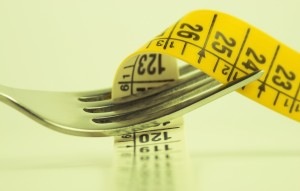How Many Calories Do You Eat In A Day?
If you don’t have a clue, you’re not alone. A lot of us don’t know how to estimate the number of calories in a meal – and on top of that, according to a Cornell study, almost everyone consistently underestimates calories as the meal size gets larger. Accuracy in estimating the number of calories we’ve eaten is determined by meal size, not the size of the person eating it. The smaller the meal, the more accurate the estimation, the larger the meal and the more people eat, the less accurate they are in estimating the number of calories. To add insult to injury, Brian Wansink, author of the book, Mindless Eating, says, “When people are eating in a restaurant that they think is healthy, people grossly underestimate how much they eat by about 50 percent.” Ouch!!!
Posted Calorie Counts Go Big Time
The health care reform act (Public Law 111-148) contains a mandate for chain restaurants to list calorie counts on their menu boards and for calorie counts to be posted next to food sold in vending machines and in retail stores. Places with 20 or more nationwide locations have to post calorie counts “in a clear and conspicuous manner,” with “a succinct statement concerning suggested daily caloric intake.” The Nutrition Labeling and Education Act of 1990 required the nutrition labels that you are used to seeing on food packages purchased in markets. That law exempted restaurants, the new law doesn’t. Some cities and states already have local laws requiring posted calorie counts. New York City was the first to require chain restaurants with more than 15 outlets to post calorie counts on their menu boards.
What Will The Labeling Law Do (or hope to do)?
Perhaps the new law will make us aware of what we’re eating and the food providers aware of what they’re serving. Improved food choices and better portion control – and menu offerings – will go along way toward healthy eating and weight management. Associating a calorie count with a portion size and meal type (big, greasy sandwiches do have lots of calories) will help educate both adults and kids. Then, perhaps, consumers will put pressure on food vendors to offer healthier choices.
Is Calorie Counting Hard To Do?
With the right tools, calorie counting isn’t difficult — although accuracy can be a challenge. There are all kinds of tools, too. There’s an array of books listing calorie counts and nutrients. There are tons of websites and phone apps that can do it for you with a minimum of effort. All packaged foods are required to have food labels and many prepared foods do as well. Posted calorie counts will be a big help. The biggest challenge is guesstimating the calories in restaurant and prepared food that doesn’t come under the calorie posting requirement. This requires guessing portion sizes – or pulling out scales and measures in a restaurant – and also guessing about a dish’s ingredients and how heavy the hand is of the person pouring the oil and greasing the griddle in the kitchen. The key is to accurately and completely write or log the accurate amount of food when you eat– not at the end of the day when it’s tough to remember the random handful of bar nuts or the snagged candy from someone’s desk.
SocialDieter Tip:
In his blog, Weighty Matters, Dr. Yoni Freedhoff calls calories “the currency of weight.” Calories are the most important factor regardless of whether you want to maintain, gain, or lose weight. You can’t see calories, or touch them, or feel them. A dish of food doesn’t sit there and say I have 549 calories in me. Instead, calories can be downright elusive. Counting calories is work – but work that can take a minimum of effort once you get the hang of it and in the habit of doing it. We don’t eat all that many different kinds of food. By measuring and learning portion sizes, then looking up calorie counts, you soon will be able to reel off the calorie counts of the food you eat all of the time. There are plenty of visual aids to help with portion eyeballing – eventually you get pretty good at it. Like so many other things, habits play a big role in what you eat, where you eat it, and how much of it you eat. Your brain is on your side, however – it likes habits – they make life easier. So, create some healthy new ones around evaluating the caloric content of what you eat.
